David Mearns – Search Director, The Finding Sydney Foundation
Before the start of our ROV dive on Kormoran’s wreck and debris field I cautioned everyone that in contrast with HMAS Sydney the wreck of Kormoran was going to be in a very bad state and that it was going to be extremely difficult to identify individual pieces of wreckage in the debris field. I did this because I wanted everyone to be prepared for what they were about to see.
As some of today’s images will show most of Kormoran’s hull has been absolutely obliterated by the final explosion, which reduced much of her structure to wreckage that is so completely twisted and torn it is virtually impossible to identify what part of the ship it comes from. I have no doubt that it was the simultaneous detonation of Kormoran’s cache of over 300 mines that ripped her apart and left the scene of utter destruction we were witnessing. The German Captain Detmers and his fellow officers had vividly described this explosion but here was the proof, once again, that they were speaking the truth and this was plain for everyone to see for themselves. The most amazing thing was that Detmers - who left Kormoran last - and those in the last lifeboat with him somehow miraculously avoided being hit by this wreckage, which clearly rained down over an area covering hundreds of metres.
The other important aspect we were able to verify was the methods the Germans used to conceal their dangerous guns in a way that allowed them to escape detection by other ships but also to de-camouflage very quickly when needed. There has been considerable doubt about the German claims that they could de-camouflage in a matter of seconds so it was especially important that we try to document exactly how the concealment flaps and covers were engineered. In terms of the engineering what we found was ingeniously simple and obviously designed for fast and efficient operation. Moreover, when you consider that Kormoran’s crew had perfected their de-camouflage techniques at least 10 times in previous battles and that they were drilled on a regular basis by Captain Detmers it is now easier to accept German claims.
The final unexpected bonus of this dive came when I spotted some writing on an enormous piece of wreckage that we struggled but finally succeeded in identifying as lower hull plate from Kormoran’s port side. The only identifiable feature for orientation was the bilge keel running left to right, but just below it painted in white were the small number and letters “08KO”. It is incredibly rare to find any writing on a shipwreck, never mind painted writing which is almost always obscured by corrosion and/or sedimentation. But there was little doubt that here on the underside of the hull in the most unusual of places was writing that positively identified the wreck as being Kormoran, the German auxiliary cruiser designated number 08.
Glenys McDonald - Director, The Finding Sydney Foundation (Observer)
Our inspection of the Kormoran wreck began with a hitch on Sunday night at 8pm when we were unable to get the ROV out of the garage. However as the first eyes to look on Sydney’s nemesis in more than 66 years we were amazed at the excellent condition of the hull. After a two hour circuit of the starboard side of the wreck we recovered the ROV for a slight repair and preparation for the next dive. We were in for a long night/morning.
At midnight we were back at our posts in the survey room and were glued to our seats for the next ten hours straight. The ROV performed perfectly and although the water clarity was at times not as good as the Sydney site, we got remarkable footage and stills.
The first thing we noticed was a light coloured paint band around the bow. As we proceeded along the starboard side we looked for items to do with the concealment of the guns and torpedoes. The torpedo flap was open and we took photographs of the hinges but it was difficult to look inside. The big 5.9” gun on the forecastle was free of concealment and trained forward. As we looked at the other 5.9” gun on the port side there were signs of paint discolouration on the barrel possibly from the intense heat. We examined the 2” guns and on both sides and the guns were missing, leaving only the mount.
Of great interest was the examination of the starboard and port underwater torpedo tubes. These were oval in shape with no form of concealment and there were seven strakes between the well deck and tube. The cargo hold was empty although what looked like a boat cradle was evident. I could not help but be impressed at the apparent neatness of this ship, even though she had been ripped apart by a huge explosion from the bridge superstructure to the stern.
When you have been awake for so many hours it is a wonderful gesture when Jo the cook, sent Sonia down with toasted sandwiches.
John Perryman – Senior Naval Historian (Observer)
Having arrived at the Kormoran wreck site during the afternoon of 6 April we conducted our first dive on the German raider between 20:00 and 21:00. Unfortunately this dive had to be cut short due to the ROV becoming lodged in its garage. We were, however, able to carry out a short preliminary examination of Kormoran from within the garage, from which we viewed a number of distinguishing features and confirmed her identity.
At 00:50 we again closed up to continue our survey of the German raider. The ROV maintainers had succeeded in clearing the obstruction that prevented the submersible from exiting its garage and it was soon on the sea bed at a depth of 2580m.
During the next six hours we retraced our steps around Kormoran and David Mearns was able to capture some very crisp imagery of what remained of the battered auxiliary cruiser. The largest part of Kormoran consisted of the well deck and bow section forward of where the main superstructure screen was supposed to be. Everything behind this had been completely obliterated, scattering chunks of twisted debris for hundreds of metres around the wreck.
The fore part of Kormoran immediately became our main target of interest and I was extremely interested to view this mysterious chameleon of the sea. We quickly identified the openings for her above water torpedo tubes which were easily identifiable by a rectangular steel plate flap which was in the open position, raised at 90 degrees. Unfortunately we were unable to get the ROV into a position to view inside the opening and therefore could not determine what state the torpedo tubes were in. As we manoeuvred the ROV lower down the ships port and stbd sides we found the oval openings for both of the fixed under water torpedo tubes.
Returning to main deck level we observed the three forward holds, the centre one of which housed one of Kormoran’s 5.9-inch guns. This gun appeared largely in tact in spite of the presence of downed derricks and Samson posts which lay across her deck. The gun was trained to starboard on a relative bearing of approximately 135 degrees. Continuing forward we observed displaced and empty boat cradles in cargo hold number one before continuing to the raised forecastle deck.
Immediately below the aft end of the forecastle were the two forward 5.9-inch guns, their concealing steel covers were gone and both were trained in the fore and aft position. On the deck above we observed the mounts for the smaller calibre 2-cm guns. Although the actual guns were gone, the port mount’s concealment remained and confirmed that these weapons were raised hydraulically from the deck below once their covers were removed.
After examining the main part of the Kormoran wreck we proceeded into the vast debris field looking for large pieces of wreckage. Few were encountered and due to the damage caused by the detonation of Kormoran’s 300 plus mines, it was very hard to determine what they were. We believe we found part of the forward deck house and also what appeared to be one of Kormoran’s engines. What was clear to me is that Kormoran’s demise was violent and complete.
Dr. Michael (Mac) McCarthy – Curator of Maritime Archaeology, WA Museum (Observer)
One of the great expectations I had of both HMAS Sydney and HSK Kormoran would be that they would conform to what in maritime archaeological circles is known as the ‘waterline theory’ i.e. that wrecks lying upright on a soft bottom sink down to the waterline, precluding a look at what has happened below the waterline. At HMAS Sydney it certainly didn’t hold good for she lies on a veneer of soft sediment overlying a compacted firm bottom. Though she was on a slight heel, on both her port and starboard sides her bilge keels were visible, showing an intact hull below the waterline in all bar the break in the bow on the port side where the Kormoran’s torpedo hit.
As we approached the Kormoran near midnight Sunday I wondered what would be the case there. So too did the Electric Pictures camera crew of Matthew Kelley Director; Ulrich Krafzik cinematographer and Christopher MacGregor the sound recordist. ‘Ulli’ was especially interested for he had been born in Kiel and lived in Hamburg as a boy; moving to Australia just 12 years ago. The relief on his face was obvious when I told him that the disguised heavily armed cargo boat was a British invention. Called ‘Q Ships’ they became famous in WWI for tricking U-boat commanders into thinking they were harmless steam or sailing tramps, only to be met with a hail of devastating fire on surfacing to finish of their hapless victim. They proved so successful that they are mentioned in Shipping Wonders of the World, one of my favourite books when I was young.
At Kormoran it was exactly the same situation as with HMAS Sydney, with the bilge keels visible on both sides aft. This left both her underwater torpedo tubes clearly visible even though in part they dripped with the now well-known ‘rusticles’ of Titanic fame. The other great surprise was that the hull abruptly ended at the bridge and it had totally disappeared; a full two thirds of the ship and all its contents gone. What was equally odd for me was the empty starboard hawse. It certainly once had an anchor, for the scrape of its flukes against the hull was clearly visible.
Soon we spotted it, still attached to its chain just inboard of the hawsepipe, its shank lying on the forepeak deck, but the flukes had gone! That certainly raised a lot of unanswered questions amongst the crew of Geosounder who when off watch or off duty in the galley, gathered to watch events unfold. Sometimes nearly 20 folk in all were crowded in.
At 0423H we retrieved the ROV and headed for the first of the Kormoran debris fields. It had two elements, one 490m away on a bearing of 211 degrees from the Kormoran’s hull and the other 1200m away on a bearing of 351 degrees. The first comprised two very large targets surrounded by hundreds of smaller strikes. They were found to be parts of the superstructure nearly 15m high and twice that in length. The second was the engine sitting on its elevated double bottom under collapsed plates and what appeared to be skylights . It too was c. 15m high. On one section of hull plate hiding it from view, was clearly visible in paint 08KO, clearly a reference to Kormoran. Also clearly visible was a stockless anchor that had torn its way deep into the same plates. While otherwise in perfect condition, its shank had disappeared!
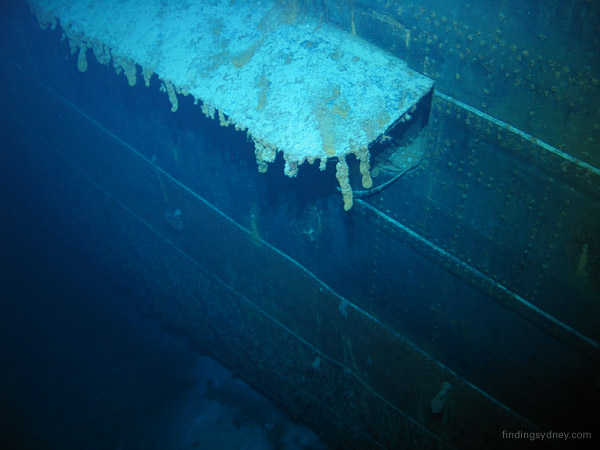
Above Photograph: The simple flap designed to conceal the starboard and port above-water torpedoes shown here on the starboard side in the open position.
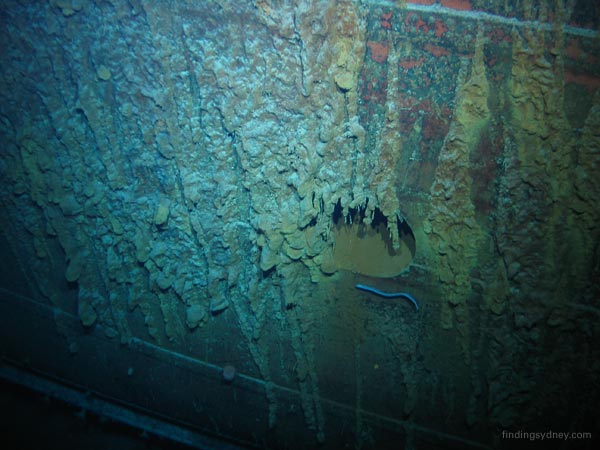
Above Photograph: The opening of Kormoran’s underwater torpedo tube on the starboard side. Although rusticicles are partially obstructing the opening it can be seen to be oval in shape to allow firing of the underwater torpedoes at the angle from which the tubes are mounted in the hull.

Above Photograph: The break in Kormoran’s riveted steel hull bears testimony to the violence of the detonation caused by her scuttling charges and mines that sent her to the bottom.
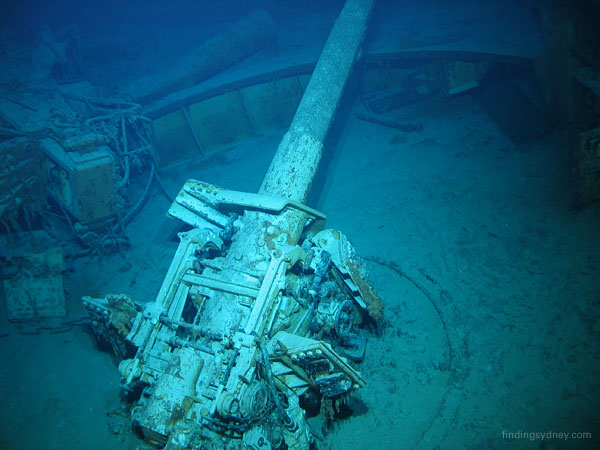
Above Photograph: 5.9 Gun: Kormoran’s 5.9-inch gun in the forward hold pointing to starboard and aft of the beam.

Above Photograph: An example of the many large pieces of twisted metal scattered throughout Kormoran’s vast debris field.
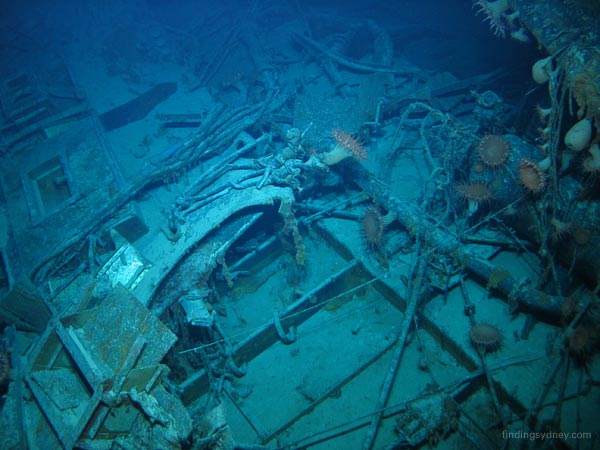
Above Photograph: Another large piece of wreckage shows a confusing jumble of pipes, cable and hull structure.
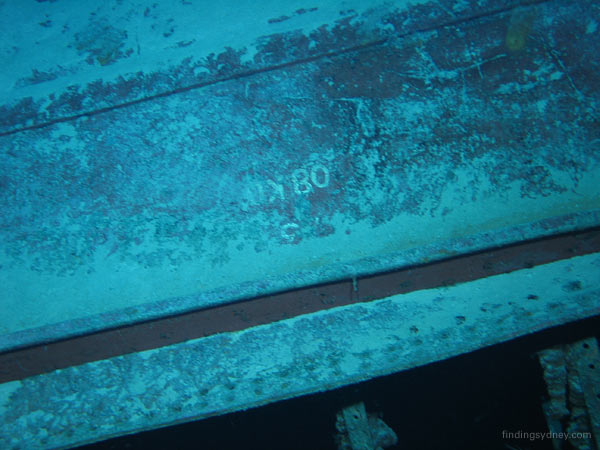
Above Photograph: The writing “08KO” painted in white on the hull just beneath the bilge keel identifying the wreck as HSK8 Kormoran. This is the actual photograph as taken by the ROV, but the image must be turned around to read the writing correctly.
Photo Gallery Slideshow available at http://www.findingsydney.com/gallery.asp
IMPORTANT NOTICE: The Material (including photographs) available in the "Press Room" section of this Website may be used/reproduced unaltered by your organisation (unless stated otherwise within the content description) subject to the terms and conditions set out in the Legal Section AND any Material (including photographs) which you use/reproduce must credit the source as "The Finding Sydney Foundation" and, as an option, you may also link the source statement with the website address http://www.findingsydney.com/.
Photographer: David Mearns